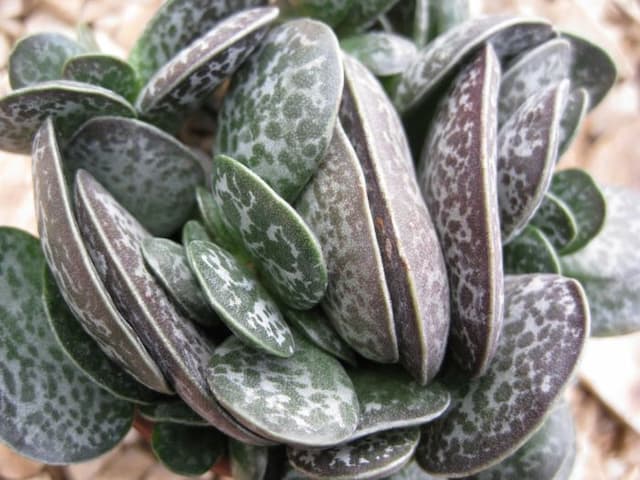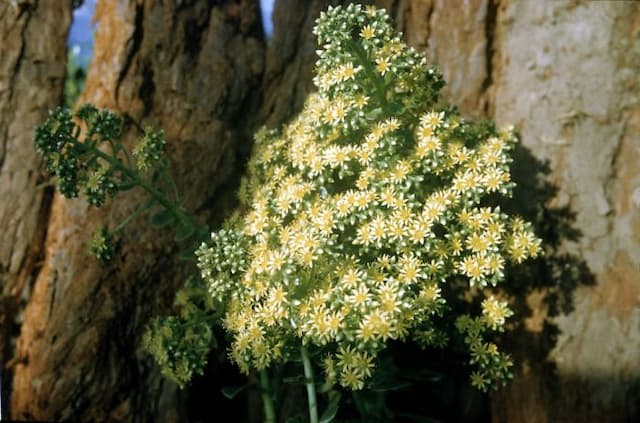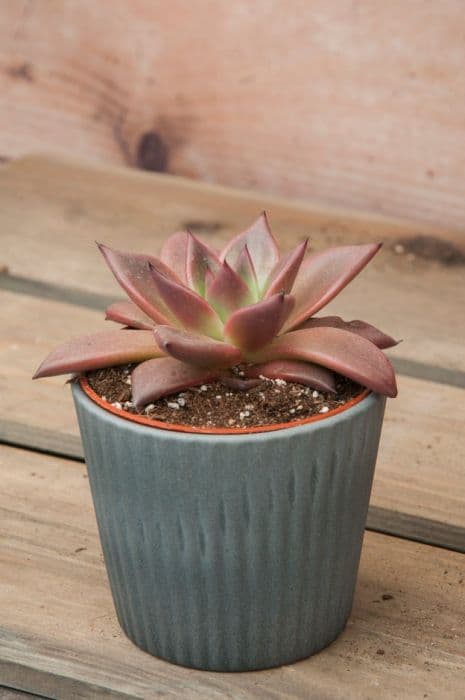Bear's Paw Cotyledon tomentosa subsp. tomentosa

ABOUT
Cotyledon tomentosa subsp. tomentosa, commonly known as Bear's Paw, is a distinctive succulent plant characterized by its chunky, fleshy leaves that resemble a bear’s paw. Each leaf is typically a vibrant green with a velvety texture and has small indentations at the tips, giving the impression of claws. These claw-like tips are often tipped with a reddish or brown color, which can become more pronounced when the plant is exposed to bright sunlight. The leaves grow in a rosette pattern, with new leaves developing from the plant's center, curving outwards to create a full, lush appearance. Bear's Paw is also known for its bell-shaped flowers, which usually bloom in warmer months. These flowers can be a range of colors from yellow to orange, adding a splash of color to the plant's appearance. Overall, the Bear's Paw is a compact and attractive succulent, popular among plant enthusiasts for its unique leaf structure and minimal care requirements. It often thrives in well-draining soil and requires plenty of sunlight to maintain the characteristic coloration of its 'claws.' This plant makes for an excellent houseplant or addition to a succulent garden, with its plush, distinctive leaves providing an interesting visual contrast to other plants.
About this plant
 Names
NamesFamily
Crassulaceae
Synonyms
Bear's Paw, Kitty's Paw
Common names
Cotyledon tomentosa var. ladismithiensis
 Toxicity
ToxicityTo humans
Bear's Paw is considered to be toxic if ingested. It contains compounds that can cause symptoms such as nausea, vomiting, and diarrhea. In some cases, it may also lead to more severe consequences such as an abnormal heart rate or changes in liver function if consumed in large quantities. It is important to avoid eating any part of the plant and to keep it out of reach of children who may be tempted to put it in their mouth.
To pets
Bear's Paw is toxic to pets if ingested. It can cause symptoms similar to those in humans, like vomiting, diarrhea, and lethargy. In severe cases, ingestion can result in more serious health issues such as heart irregularities or liver damage. It is essential to prevent pets from chewing on or ingesting any part of the plant, as even small amounts can be harmful.
 Characteristics
CharacteristicsLife cycle
Perennials
Foliage type
Evergreen
Color of leaves
Green
Flower color
Yellow
Height
1 foot [30 cm]
Spread
2 feet [60 cm]
Plant type
Succulent
Hardiness zones
9
Native area
South Africa
Benefits
 General Benefits
General Benefits- Easy to Care For: Cotyledon tomentosa subsp. tomentosa, commonly known as Bear's Paw, is a succulent that requires minimal watering and maintenance, making it ideal for busy individuals or those new to gardening.
- Drought Tolerant: The Bear's Paw is highly drought-tolerant, conserving water in its leaves and thriving in drier conditions where other plants might struggle.
- Decorative Appearance: With its unique, paw-like leaves that have a velvety texture and reddish tooth margins, the Bear's Paw adds aesthetic beauty to any space.
- Compact Size: This plant remains relatively small, which is perfect for indoor spaces and small gardens where space is at a premium.
- Promotes Well-being: As with many houseplants, the presence of Bear's Paw in the home can create a calming and relaxing environment, contributing to overall well-being.
- Propagation Ease: It can be easily propagated from cuttings or leaves, making it simple for hobbyists to expand their collection or share with friends.
- Non-Toxic to Pets: This particular subspecies of Cotyledon tomentosa is non-toxic, making it a safer choice for households with pets.
 Medical Properties
Medical PropertiesThis plant is not used for medical purposes.
 Air-purifying Qualities
Air-purifying QualitiesThis plant is not specifically known for air purifying qualities.
 Other Uses
Other Uses- Cotyledon tomentosa subsp. tomentosa, commonly known as Bear's Paw, can be used as a low-maintenance ground cover for water-wise gardens due to its drought tolerance and spreading habit.
- The fleshy leaves of Bear's Paw can be used in creating succulent arrangements and fairy gardens, offering unique textures and forms that complement other plants.
- This plant's distinctive paw-like leaves make it a popular decorative item for office desks or shelves, providing a playful touch to workspaces.
- Bear's Paw can add an interesting tactile experience to sensory gardens, with its soft, furry leaves being particularly appealing to touch.
- The plant can be used in educational settings, such as schools or botanical workshops, to teach children about plant morphology and water storage in succulents.
- Bear's Paw is sometimes utilized in photography and art as a subject for still life compositions due to its unique and quirky appearance.
- The plant can be featured in succulent wreaths or living wall art, where its leaves can add depth and contrast amongst other succulent varieties.
- As a part of drought-resistant landscaping themes (xeriscaping), Bear's Paw contributes to sustainable garden practices while providing an attractive aesthetic.
- For themed parties or events, Bear's Paw can serve as a natural table decoration that fits in with a rustic or eco-friendly decor style.
- Bear's Paw, when included in mixed succulent container gardens, can play a structural role, providing height and visual interest among lower-growing species.
Interesting Facts
 Feng Shui
Feng ShuiThe Bear's Paw is not used in Feng Shui practice.
 Zodiac Sign Compitability
Zodiac Sign CompitabilityThe Bear's Paw is not used in astrology practice.
 Plant Symbolism
Plant Symbolism- Endurance: The Cotyledon tomentosa subsp. tomentosa, commonly known as Bear's Paw, is a succulent that can hold water in its leaves and survive in dry conditions, symbolizing the ability to endure and thrive in challenging environments.
- Protection: With the 'paws' appearing as if they have claws, they can symbolize a protective nature or the need to guard oneself or one's loved ones.
- Uniqueness: The peculiar shape and the fuzziness of the leaves make Bear's Paw a unique plant, symbolizing the celebration of individuality and non-conformity.
- Prosperity: Like many succulents, Bear's Paw is often considered a token of good fortune and prosperity due to its plump leaves that resemble a full coin purse or wallet.
 Water
WaterThe Bear's Paw (Cotyledon tomentosa subsp. tomentosa) should be watered sparingly as it is a succulent plant that is prone to overwatering. It's crucial to allow the soil to completely dry between waterings. Typically, watering once every two to three weeks is sufficient, but this can vary depending on the humidity and temperature. When you do water, give the plant a thorough soaking so that water reaches the entire root system. You will likely need about 8 to 16 onzes of water every two weeks, adjusting as necessary for your environment.
 Light
LightThe Bear's Paw thrives in bright, indirect sunlight. It can tolerate some direct sun, especially in the morning, but it's important to protect it from the harsh afternoon sun which can scorch its leaves. A spot near a south or east-facing window where it can get plenty of light without being directly under the sun's rays all day is ideal.
 Temperature
TemperatureBear's Paw prefers temperatures between 60 and 80 degrees Fahrenheit, which provides an ideal growing environment. It can survive in temperatures as low as 30 degrees Fahrenheit but should be protected from frost. Keep the plant away from cold drafts in winter and extreme heat during the summer to maintain optimal growing conditions.
 Pruning
PruningPruning the Bear's Paw is important to remove any dead or damaged leaves to encourage new growth and maintain a compact shape. The best time to prune is in the spring or early summer at the start of its growing season. Pruning occasionally is often enough, whenever you notice damaged leaves or if the plant becomes too leggy.
 Cleaning
CleaningAs needed
 Soil
SoilThe Bear's Paw (Cotyledon tomentosa subsp. tomentosa) thrives in a well-draining cactus or succulent mix with added perlite or pumice to enhance drainage; the ideal soil pH is around 6.0.
 Repotting
RepottingBear's Paw should be repotted every 2-3 years or when outgrowing its container to ensure healthy growth.
 Humidity & Misting
Humidity & MistingBear's Paw prefers low humidity levels typical of arid environments, avoiding excessive moisture which can lead to rot.
 Suitable locations
Suitable locationsIndoor
Place Bear's Paw in bright, indirect light indoors and allow soil to dry between watering.
Outdoor
Plant Bear's Paw in well-draining soil, full sun to partial shade.
Hardiness zone
9-11 USDA
 Life cycle
Life cycleCotyledon tomentosa subsp. tomentosa, commonly known as Bear's Paw, begins its life cycle when seeds germinate in warm, well-draining soil, typically in the spring or summer. The seedlings develop fleshy leaves that exhibit the characteristic 'paw'-like shape with reddish tooth-like margins, which is a sign of its initial vegetative growth phase. As the plant matures, it enters a prolonged vegetative stage, with leaves growing larger and the stem thickening to support the succulent leaves. Flowering occurs generally in late spring or early summer, producing bell-shaped orange to yellow flowers on tall stalks above the foliage, representing the reproductive phase. After pollination, seeds are set, and once mature, they are dispersed to begin a new generation of plants. Throughout its life, Bear's Paw goes through periodic dormant phases, especially in cooler temperatures, where it requires less water and ceases active growth.
 Propogation
PropogationPropogation time
Spring to Summer
Propogation: The most popular method of propagating the Bear's Paw (Cotyledon tomentosa subsp. tomentosa) is through leaf cuttings. To propagate by leaf cuttings, a healthy leaf is gently twisted off the plant ensuring that no part of the leaf is left on the stem, as this might prevent it from rooting. The leaf is then left to callous over for a few days in a warm, dry place, which helps to prevent rot when the leaf is planted. Once the cut end is calloused, the leaf is placed on top of a well-draining soil mix, and kept in a bright area with indirect sunlight. It's important to water sparingly, just enough to keep the soil slightly moist, as too much moisture can cause the cutting to rot. Roots and new shoots typically emerge from the base of the leaf after a few weeks. This method is effective and is often preferred because it allows for the creation of multiple plants from a single leaf.









